PROVINCETOWN — The sun broke through a dense fog. The town hall clock chimed, tourists rolled suitcases down Commercial Street, and there was something new: a glass elevator glided up and down High Pole Hill.
Pilgrim Monument
LIBERATION
Juneteenth in Provincetown: Celebration and Education
‘What we asked for is for Black lives to matter’
PROVINCETOWN — Activists, vacationers, local residents, a handful of elementary school students, community elders, drag queens, religious leaders, business owners, and a few politicians gathered at the base of the Pilgrim Monument on Saturday morning to celebrate Juneteenth.
A Christmas Gift of Chamber Music
Chamber Music for the Outer Cape, a group started in 2018 that was “designed to provide classical concert opportunities in the off season,” according to its artistic director, Craig Combs, will be giving a virtual Christmas concert this year. The link will be available starting Tuesday, December 15th at pilgrim-monument.org.
It will be “all classical music with a couple classical Christmas numbers,” says Combs. The program includes, among other pieces, Corelli’s “Christmas Concerto,” Schoenberg’s Weihnachtsmusik (or “Christmas music”), Vaughan Williams’s Fantasia on Greensleeves, Prokofiev’s “Troika,” Leroy Anderson’s “Sleigh Ride,” and “The Christmas Song” by Mel Tormé.
The concert is free, a “gift to the community” from Chamber Music for the Outer Cape and the Pilgrim Monument and Provincetown Museum. —Saskia Maxwell Keller
CURRENTS
This Week In Provincetown
Meetings Ahead
Meetings are held remotely. Go to provincetown-ma.gov and click on the meeting you want to watch.
Thursday, Nov. 5
- Harbor Committee, 5 p.m.
- Zoning Board of Appeals, 6 p.m.
Tuesday, Nov. 10
- Licensing Board, 5:15 p.m.
Thursday, Nov. 12
- Planning Board, 6 p.m.
Conversation Starters
Covid-19 Update
As of Nov. 3, Provincetown had three active cases of Covid-19, 34 cases considered recovered, and one death.
Dormitory’s ZBA Permits Not Contested
In September, the zoning board of appeals awarded three special permits to Patrick Patrick for the 28 dormitory-style units and 16 small apartments he wants to build on his land between Route 6 and Province Road. The 20-day window to challenge that ZBA decision in Mass. Land Court has passed, and no challenge was filed, according to Acting Town Clerk Ana Ruiz.
The project will next have to obtain approvals from the planning board, which has jurisdiction over issues like congestion, noise, and community character. The select board has already awarded the project 9,150 gallons of wastewater capacity.
Lighting of the Monument on Nov. 11
The only official observance of the 400th anniversary of the arrival of the Mayflower in North America will be the lighting of the Pilgrim Monument on Nov. 11 between 6 and 6:30 p.m. A wide range of other plans, including a visit from the reconstructed Mayflower II and an event with the Wampanoag tribe, all had to be canceled because of Covid-19.
“I had been hoping we could offer fireworks” on Nov 11, said Pilgrim Monument and Provincetown Museum Director David Weidner. “Alas, everything Provincetown 400 was just not to be this year.
“We do have an amazing new permanent exhibit dedicated to the native Wampanoag people,” Weidner added. The PMPM will be open to the public from Thursday, Nov. 5 to Sunday, Nov. 8, before closing for the season.
“We have pulled down the Provincetown 400 website, as it was event-driven, and not a content engine,” said Weidner. A wide range of online content about the 400th anniversary, including a series of short videos about Wampanoag history, can be found at Plymouth400inc.org/education. —Paul Benson
Human Services Money on the Table
For anyone wishing to help those in need, applications are being accepted for the Provincetown Human Services Grant Program.
Applicants must address the following needs: mental health services, substance abuse services, services for children, teens or families at risk, as well as older adults, domestic violence services, housing, hunger, legal services, services for people with disabilities, or people living with HIV or other chronic conditions.
The deadline for submission is noon on Tuesday, Dec. 1. For further information, contact Chris Hottle, director of the Dept. of Human Services, at [email protected] or (508) 487-7080. —K.C. Myers
PROVINCETOWN 400
PAAM and Pilgrim Monument Host Art Exhibit
A show of 33 expressions of freedom
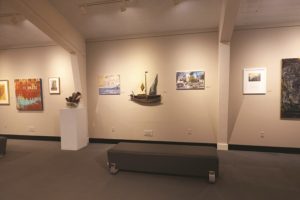
The Provincetown Art Association and Museum has joined forces with the Pilgrim Monument and Provincetown Museum for “Members’ Juried: Provincetown 400,” an exhibit of artwork by PAAM members that is on view at PMPM’s East Gallery through the end of the year 2021.
The theme of the show is “liberty, justice, and freedom of expression.” Though a theme as open-ended as “liberty” runs the risk of including everything, the selected artwork is appropriate and relevant, and pushes the theme’s concept in interesting ways. The jurors — Megan Hinton, Joe Fiorello, and Jane Paradise — chose 33 pieces out of 108 submissions.
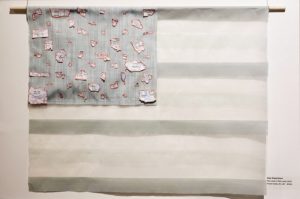
Here are some of the highlights. This Land Is Their Land, by Sian Robertson, is an American flag constructed of cloth, but instead of stars, there are map cutouts of Native American reservations.
Where Law Ends, Tyranny Begins is a serigraph, or silk-screen print, by Lee Ann Fanning. Titled after a William Pitt quotation, its ordered chaos evokes Jackson Pollock, but in a different medium.
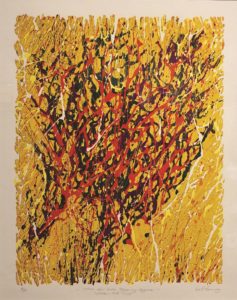
Liberty, a star-shaped sculpture by M.J. Dickson, is constructed of 1,500 matches that are meant to represent the 1,500 men from Cape Cod who volunteered to fight in the American Revolution. The matches resemble the red cap mounted on a pole that served as the first flag.
Jay Critchley’s Pilgrim Hat takes a form symbolic of America’s beginnings, and constructs it out of codfish skin, something once plentiful that is now overfished. This fits with Critchley’s current “Democracy of the Land” series, which points to the introduction of Europeans to North America as the source of environmental catastrophe.

Larry R. Collins’s Vietnam Still Life is expertly painted. A bust of a soldier in a camouflaged combat helmet, his lips curled nearly into a sneer, sits atop a stack of books, where the artist, a Vietnam vet, has signed his name. Like all busts, this one is missing its arms, but is that also a bullet hole in the soldier’s chest? A knife rests in a crystal goblet beside him.
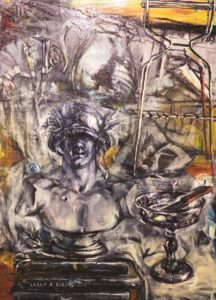
The abstracted human forms in Daniel Wagner’s Freedom to Assemble recall the work of Paul Resika and are rendered in watercolor and pastel. Barbara Cohen’s Displacement Camps of Angola is likewise abstract but evokes crammed tents and makeshift shacks.
The only jarring note: part of the PMPM gift shop, replete with stuffed animals, has been located smack in the middle of the space. Some of the most interesting work is located around the entrance, so take your time to be sure not to miss anything. —Saskia Maxwell Keller
Art Pilgrimage
The event: “Members’ Juried: Provincetown 400” exhibit, art by PAAM members on the theme of liberty, justice, and freedom of expression
The time: Through 2021; museum hours: Thursday through Sunday, 11 a.m. to 4 p.m.
The place: Pilgrim Monument and Provincetown Museum, 1 High Pole Hill Road
The cost: One-hour time-slots at PMPM: $17; seniors and teens 13-17, $13; children 4-12, $7; under 4, free; at pilgrim-monument.org
Sudden Drop-off
The Provincetown Art Association and Museum is having two drop-off days for submissions to its Members’ Juried: Provincetown 400 Exhibition: Monday, September 14th, and Tuesday, September 15th,11 a.m. to 2 p.m. at the Pilgrim Monument and Provincetown Museum, 1 High Pole Hill Road. No size limit; one submission per member. The show will run at the PMPM from September 18th through December 31st. Membership must be valid throughout.
Sudden Drop-off
The Provincetown Art Association and Museum is having two drop-off days for submissions to its Members’ Juried: Provincetown 400 Exhibition: Monday, September 14th, and Tuesday, September 15th,11 a.m. to 2 p.m. at the Pilgrim Monument and Provincetown Museum, 1 High Pole Hill Road. No size limit; one submission per member. The show will run at the PMPM from September 18th through December 31st. Membership must be valid throughout.
GRAVEYARD SHIFT
Remembering Rosilla: The Pilgrim Monument’s Sole Victim
The freak accident that killed the Widow Bangs on Bradford Street
PROVINCETOWN — On Aug. 5, 1910, after three years of construction, Provincetown’s Pilgrim Monument, commemorating the first landing place of the Mayflower Pilgrims, was dedicated by President William Howard Taft atop High Pole Hill. Almost three years earlier, on Aug. 20, 1907, in an elaborate Masonic ceremony, the cornerstone of the monument had been laid by President Theodore Roosevelt, who arrived in Provincetown aboard the aptly named presidential yacht, Mayflower.
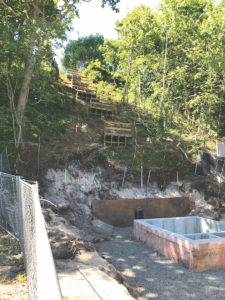
It was a source of great pride that, during the three years of construction, no workers involved in the project had been injured or killed. There was, however, one casualty, a freak accident that marred the celebratory atmosphere on dedication day.
The Pilgrim Monument had been years in the planning. It was first conceived in 1892, when the Cape Cod Pilgrim Memorial Association was formed for the purpose of erecting “some suitable structure upon Provincetown’s Town Hill.” Architect Willard Thomas Sears based his design on the Torre del Mangia in Siena, Italy. It was made of granite from Stonington, Maine, blocks of which were brought to Provincetown by barge and unloaded at the waterfront. From there they were transported across Commercial and Bradford streets to the base of High Pole Hill.
Were a Provincetown resident from 1907 to reappear in 2020, the deep scar now visible on the Bradford Street side of the hill — the future site of an inclined elevator providing access to the Monument — would look eerily familiar.
In 1907, a similar swath was cut for a railway to haul the granite up the hill in heavy steel motorized cars. By early August 1907, the foundation work that began in June had been completed, and in mid-June 1908 the tower began to rise atop the dune.
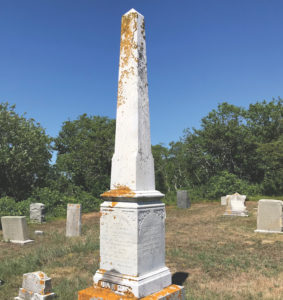
The story goes that during a thunderstorm on Aug. 5, 1908, one of the motorized cars, left empty on a level area atop the hill, was set in motion by a lightning strike that loosened its tether. Though a report in the Boston Herald disputed the lightning story, it did not change the tragic outcome. The runaway car gained velocity, and its momentum carried it through a protective timber barrier at the bottom of the hill and into the path of Rosilla (Rich) Bangs, the 84-year-old widow of Solomon Bangs, killing her instantly.
The Herald reported that a passerby who saw the car hurtling down the rails tried to warn Mrs. Bangs, to no avail. After hitting her, the car continued its rampage, crossing the street and crashing through the fence at Enos N. Young’s home at 129 Bradford St. before coming to rest in a neighbor’s yard. Rosilla’s death certificate noted the cause as a “concussion of the brain and multiple injuries accidentally received by breaking of cable and descent of the supply car for the monument on Town Hill.” Ironically, the town clerk who filed the certificate was none other than Enos N. Young. Just a year earlier, Rosilla had shaken the hand of President Roosevelt at the laying of the cornerstone.
The marriage of Rosilla Rich to Solomon Bangs Jr. continued a long tradition uniting the Rich family of Truro and the Bangs family of Provincetown. Both families have roots in Eastham, Richard Rich arriving by 1665 and Edward Bangs, who arrived in Plymouth in 1623 aboard the ship Anne, having been one of Eastham’s pioneers in 1645. In Provincetown, the family name is now immortalized on Bangs Street, once a narrow winding lane where the family owned considerable tracts.
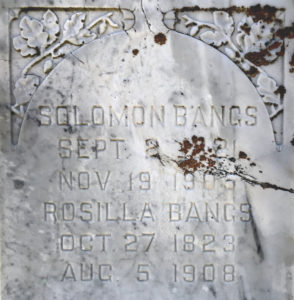
In 1848 Solomon Jr., a sailmaker and wholesale fish dealer, built his wharf in Provincetown’s East End, and by 1852 he was a pioneer of inshore weir fishing — also known as trap fishing — following a traditional method long used by Native Americans. In the early 1890s, when Solomon’s eyesight began to fail, threatening his livelihood, the entrepreneurial Rosilla had an idea. Then a woman of 70, she contacted the Boston company from whom Solomon bought his sail cloth and arranged to have tents made for a summer seaside colony she established near the Truro line on a parcel of Bangs ancestral land once owned by Capt. Jonathan Bangs (1640-1728), an original proprietor of Truro. Bangsville (now Mayflower Heights) was immediately successful and profitable.
In the Provincetown cemetery, a marble obelisk marks the Bangs family plot, where three generations rest. Inscribed on the obelisk is an epitaph to Perez Bangs (1825-1848), the younger brother of Solomon Bangs Jr., whose death at the age of 23 is yet another reminder of the price paid by so many who followed the sea.
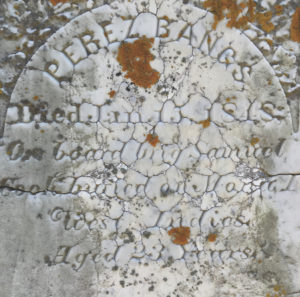
Young Perez, a crewman on the whaling brig Samuel Cook, died at sea in January 1848 and was buried on an island in the Mona Passage between Puerto Rico and the Dominican Republic. In February, when word of Perez’s death reached Provincetown, his father, Solomon Bangs Sr., chartered — at great expense — the schooner Palestine, owned by Captain Henry Whorf, to recover his son and return him to Provincetown.
Newspapers described the schooner’s voyage as a moving example of a father’s determination to bring his dead son home; one dispatch was poignantly titled “Parental Affection.” But by mid-April the Palestine had returned to Provincetown without Perez, the crew unable to find the spot where he had been buried on the uninhabited island. Sadly, the Bangs family monument also shows that Solomon Jr. outlived his son Perez, born just months before the elder Perez was lost at sea.
Editor’s note: Capt. Henry Whorf (1813-1852) was author Amy Whorf McGuiggan’s third great-grandfather. He died of yellow fever in Haiti.
PROVINCETOWN 401
Funicular Going Up
Doubled cost of project to be covered by $4.5 million loan
PROVINCETOWN — Construction on the long-planned inclined elevator that will link the Bas Relief Park to the base of the Pilgrim Monument is set to begin on May 18.
The so-called Bradford Access Project has been given new life by a $4.5 million loan from the Cooperative Bank of Cape Cod, announced this week. Despite setbacks, including a lawsuit and a pandemic, Pilgrim Monument and Provincetown Museum Executive Director David Weidner is optimistic about the project. He said that, pandemic willing, the inclined elevator will be completed by the 2021 season a year from now. The original plan was to have it ready for 400th anniversary of the Pilgrims’ arrival here this year.
“We’re creating a brand-new front door,” Weidner said. “This is to help our institution grow, and an opportunity to connect the town to the museum.”
Weidner described the inclined elevator — also known as a funicular — as similar to a regular vertical elevator, just running at an angle. “The doors open. You push a button, the doors close, and it starts to move,” he said. “It remains flat as it moves up the hill and has 360-degree windows, so you can see the entire town.”
Cables will pull the cabin up the hill along a track. It will take two and a half minutes to reach the top.
The ride won’t be free, however. To enter the lift, passengers will have to buy an admission ticket to the museum and monument, either at the parking lot on top of the hill, at a kiosk at the bottom of the hill, or on their phones from anywhere. The ticket will act as a day pass, allowing rides all day. The current admission prices for adults, seniors, and kids are $17, $13, and $7, respectively.
Year-rounders and property owners don’t get special treatment or free rides. “We don’t have any local access built into the plan at this point,” Weidner said. “We’re really working hard on financing.”
Weidner had previously estimated the total cost of the project at about $2.2 million. The museum announced on Monday that the Hyannis-based Cooperative Bank of Cape Cod had signed on as a financial partner and would finance a $4.5 million loan.
Weidner said that the increase in costs was due to more extensive planning and regulatory work. “There was more cost on the engineering and architecture side, and the initial plan did not have as much handicap access,” he said.
The new plan includes two accessible car parking spaces and a ramp to the monument on the hilltop, and a virtual interactive display inside the museum, so that people who cannot climb the monument’s stairs can participate in a virtual reality tour of the views on top.
Weidner would not comment on whether a lawsuit filed by an abutter that was settled last year contributed to the project’s increased cost.
Plans for construction were delayed by a lawsuit filed in January 2019 by Paul Teixeira, who owns an abutting property at 116 Bradford St. Teixeira was concerned about traffic resulting from the project and the hill’s ability to support a 50-ton funicular system.
PMPM and Teixeria reached a settlement in July, and building permits were issued for the project shortly thereafter.
Funding for the project has also been provided by the Mass. Cultural Council and Mass. Development Finance Agency. The PMPM website also welcomes donations towards the project.
By creating a handicap-accessible link between Bradford Street and the museum, the project aims to “facilitate even more commerce with our local businesses and excitement for visitors,” the website states. “The Monument stands tall as a beacon of welcoming, tolerance and acceptance…. This is just the first step in a journey to transform PMPM from a local, community museum into a world-class destination for history enthusiasts.”
The inclined elevator, Weidner said, is the first phase of the PMPM campus renovation. The second phase will be focused on the museum itself.
The Pilgrim Monument will also be lit in support of pandemic front-line workers. Starting on May 1, the monument’s base will be bathed in red light for essential workers, like grocery store employees, and the belfry will be lit up in blue, for health-care workers.
Isolation
The Pilgrim Monument shelters in place.

